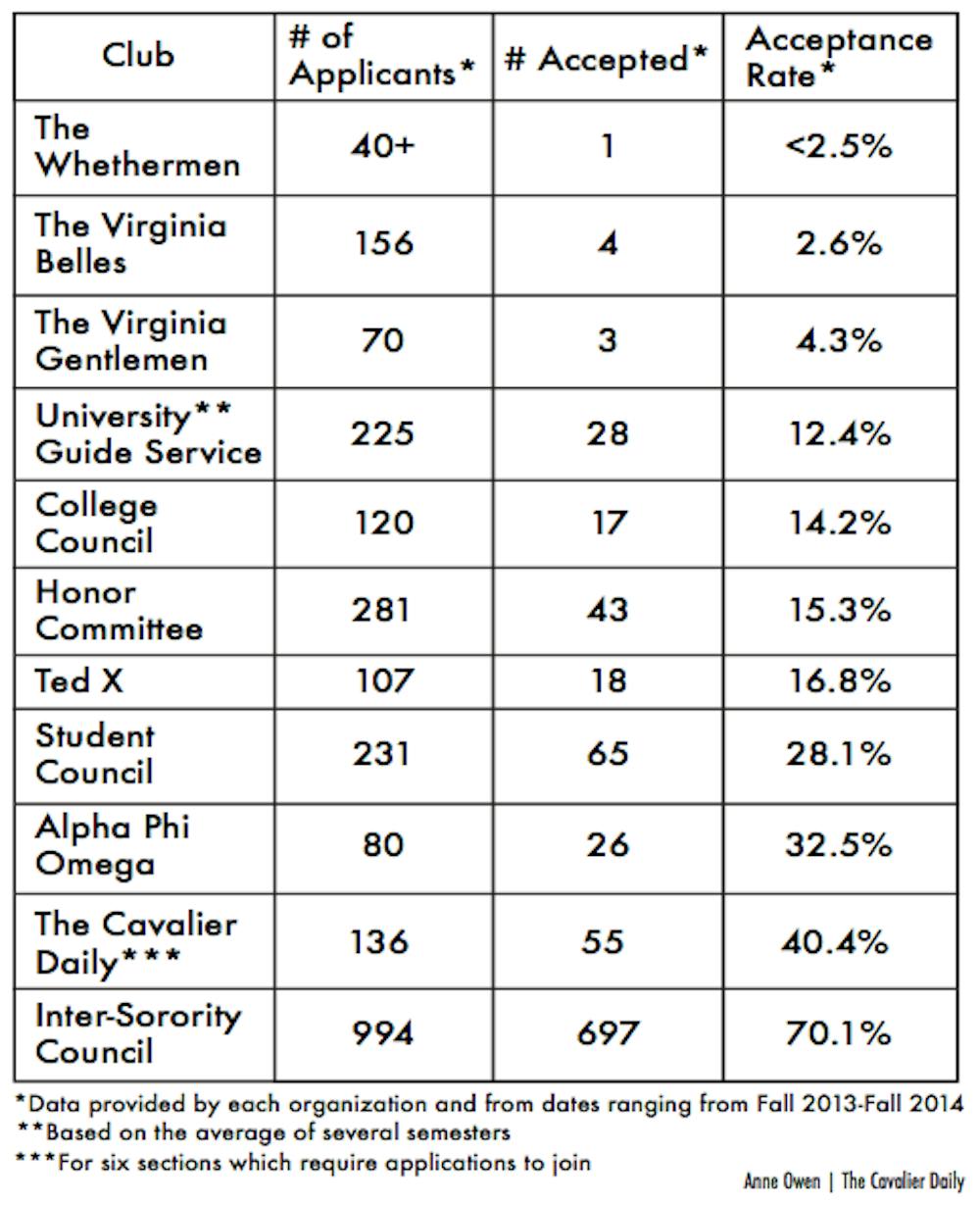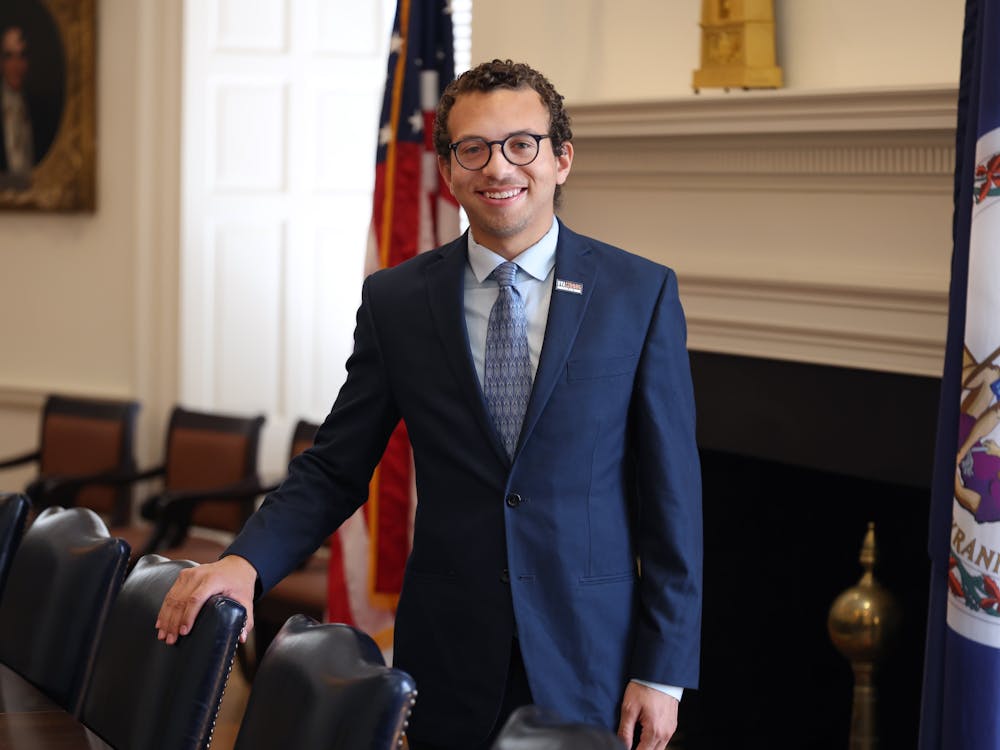As September comes to a close, most upperclassmen have re-entered the academic mode. First years are continuing to acclimate to a new environment. And organizations, both on Grounds and off, have nearly finished recruiting new members.
Not everyone, however, is now involved in his or her extracurricular activity of choice. With many popular and well-known groups at the University holding application or try-out processes which necessarily restrict membership, securing University involvement can at times appear a function of either luck or privilege.
In discussing the competitiveness of extracurriculars, however, Dean of Students Allen Groves warns of tunnel vision. In an effort to get involved, some students concentrate on the most visible organizations on Grounds, he said.
“Too many young people focus on four to five organizations, when we have 700,” Groves said. “There are a handful of organizations, that, because they are high profile, students believe they need to be part of if they are going to have the U.Va experience.”
Name recognition and its accompanying prestige, then, creates highly-selective application processes to join some of the most well-known student groups.
The University Judiciary Committee, for example, evaluated 144 applicants this fall and took “around 40,” said UJC Chair Timothy Kimble, a fourth-year College student. The UJC application rate, then, was 27 percent.
Similarly, in 2013, the Honor Committee received 281 applications, ultimately accepting 43 students (15 percent), while College Council accepted only 17 of the 120 students who applied to be underclassman representatives (14 percent).
And such competition is not limited to organizations predicated on student self-governance. Performance groups also boast similarly steep acceptance rates for new members.
Last spring, more than 40 students tried out for the Whethermen, an improv comedy group. Only one new member was accepted.
A cappella groups the Virginia Belles and the Virginia Gentlemen, which generally have few openings in already small ensembles, had acceptance rates of 2.6 percent and 4.3 percent, respectively, this fall.
Not all groups disclose their acceptance data. The Jefferson Literary and Debating Society declined to release all of its figures from their fall 2014 tryout process.
“We do not have a membership quota, expected class size, or percentage admitted, and releasing the figures from this fall may serve to confuse that message,” fourth-year College student Kate Kingsbury, membership chair of the Jefferson Literary & Debating Society, said in an email.
A list circulated of accepted members showed the Jefferson Society ultimately accepted 51 applicants this fall.
The University Programs Council and the Virginia NoTones also declined to release their acceptance data.
But not all organizations are this exclusive. The craze of competition revolves around a relatively small number of organizations — many, if not most, organizations are open to all who are interested, including sizable groups like Sustained Dialogue and the International Relations Organization.
Characterizing Involvement
Inspired by a tradition of student engagement but limited by a concentration on specific clubs, students fight what third-year College student Emma Myers called an “uphill battle” to get involved in popular groups.
Myers, who sits on the executive board of the International Relations Organization and is a member of the University Guide Service, said that for students, competition lends groups a sense of legitimacy.
“Your involvement is somehow more valid if you competed with 10 people for that one spot,” Myers said.
Fourth-year College student Lauren Schauer, who is on the executive board of University Democrats and is a founding member of the group United for Undergraduate Socio-Economic Diversity, echoed a similar sentiment.
“You have to be competitive to be cool,” Schauer said.
Fourth-year College student Katie Somers, co-chair of Housing and Residential Life, said extracurricular involvement is encouraged from the beginning of first year.
“As Resident Advisors and Senior Residents, we encourage our students to get involved in the University from the get-go,” Somers said.
Involvement outside the classroom can become a key part of a University student’s identity.
“People associate being involved with being a part of the U.Va. community,” said third-year College student Grace Muth, a senior support officer for the Honor Committee.
Administratively-promoted values of student self-governance and engagement may work to reinforce this image.
“At an institution that values student self-governance and leadership, student involvement plays a large role in the U.Va. experience,” Interim Director of Student Activities Emily Miles said in an email.
Myers said this spirit of involvement is something the student body should take pride in.
“Being told to take ownership of your school … to engage in your community is a beautiful thing,” Myers said.
Consequences of competition
But the narrative of student involvement at the University, while at times empowering, can at times overwhelm students, pressuring them to feel involved while making uninvolved students an anomaly.
“If someone told you they don’t do anything other than go to class, that would come as a shock to you,” Schauer said.
Oftentimes, pressure does not end when a student joins a club, with even involved students saying they sometimes feel they do not feel adequately committed.
“Even if you have no more hours in the day to commit to something, you still feel like you should be doing more,” Muth said. “It’s never enough.”
In an effort to play the part of the involved University student, students look to certain organizations as a means to focus extracurricular involvement. In such a narrow and competitive context, however, some students may fall through the cracks.
“I think a lot of people get overlooked,” said fourth-year Architecture student Henry Brazer, a Resident Advisor and Trustees committee member.
Resident advisors often witness the first round of extracurricular rejection firsthand. With many first-year students boasting strong high school résumés, this rejection can come as both a shock and jarring disappointment.
“The only really tough part about the club/organization application process is seeing your resident go through any kind of rejection,” Somers said. “As a RA it is your role to make that a learning moment for your resident.”
Groves recognized rejection can trigger a host of negative emotions.
“I think some young people feel defeated, or that they have failed when they don’t get some of the opportunities,” Groves said.
To some extent, competition is inevitable. No matter how many students apply, organizations have finite resources, and can only offer a certain number of spots — a phenomenon not exclusive to the University.
“Though it’s prevalent at U.Va. ... this happens at other schools,” Brazer said.
Nor is competition a foreign concept to many students, who come from competitive high school environments and expect competition in their future careers, Brazer said. Groves said aspects of competition are healthy and promote student engagement.
“At the end of the day, selectivity isn’t bad,” Groves said. “It’s OK for clubs to be selective, so long as they do so in a non-discriminatory manner.”
A University culture
Though it exists other places, competition has taken an especially strong hold at the University, Myers said.
“[Competition is] exacerbated by certain traditions and a culture that is distinct to U.Va.,” Myers said.
The University also attracts a competitive crop of students, Groves said.
“Because of self-governance and the way in which we position the University over the years, I think that we do attract young people that are focused, driven and competitive,” Groves said. “And I mean competitive in a healthy way.”
Some facets of a competitive atmosphere are promoted over time, however.
“There is mentality every club has to have an application,” Schauer said. “I’ve been in meetings where we said, ‘We want a lot of people to join, but we have to have an application.’ We never really have a good reason. We just think it is something clubs do.”
Linking an organization’s exclusivity to its legitimacy may have lasting repercussions — encouraging students to pursue activities without genuine interest.
“My first year, part of what I was thinking was, ‘Let’s get into the most exclusive club I can,” Muth said. Amid the uncertainty of first year, adrift in a sea of strangers, it becomes a way to validate yourself,” she said.
Groves said he thinks some people may initially join certain groups out of a desire to appear successful.
“It’s great to go out for those organizations if that is really where your interest lies, but I fear a lot of people go out for them because they believe it’s an important box to check while they’re here,” Groves said.
First-years do not come to these notions on their own. Intense competition and limited acceptance to these clubs create the impression of what Brazer called an “elite group.”
“It makes it seem like U.Va. is controlled by a small percentage of people,” Brazer said.
Moving Forward
“You could argue [competition] is negative, you could argue it’s positive,” Myers said. “I think the issue has a little bit of both to it. There is no absolute here…"
[The issue] needs to be talked about — not in a way of accusing the culture, but in a way that opens the dialogue,” Muth said.
Promoting a culture of genuine involvement would counteract competition, Brazer said.
“Do what you really want to do,” Brazer said. “Not what you think you should do or what everybody else is doing.”
Schauer noted, additionally, that involvement with big-name organizations does not necessarily imply a desire to be exclusive.
“There are people in the big organizations who truly care about their missions,” Schauer said.
Groves said students should better define success outside involvement in a small subsection of groups, and advertising to first-year students should promote a broader array of groups. Groves called RAs and Orientation Leaders “critical players” in this effort.
“There are so many different paths [to success] … and I think we need to make that more visible to students,” Groves said.
All statistics were voluntarily provided by the relevant organization or publicly-available lists.







